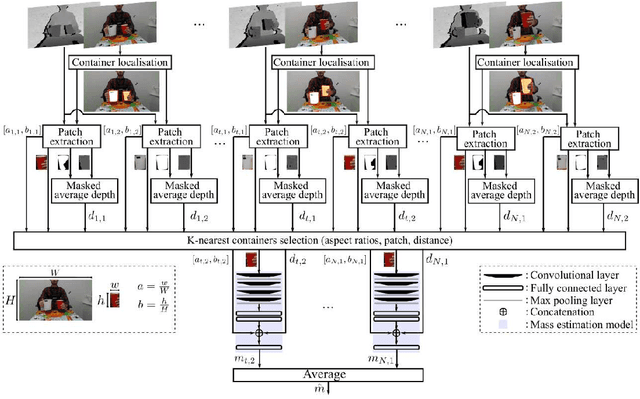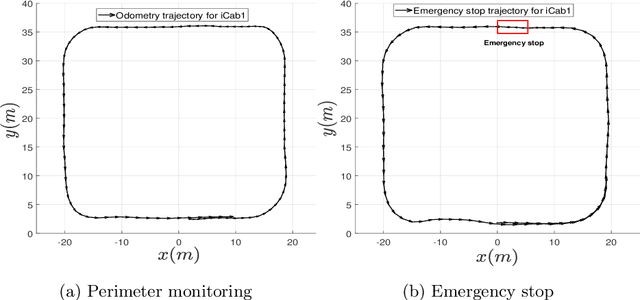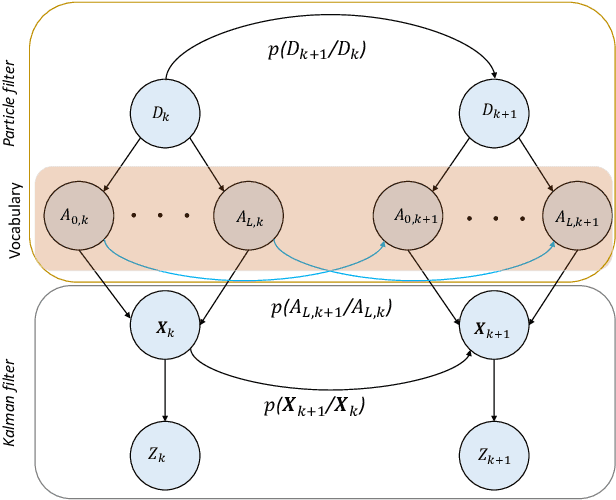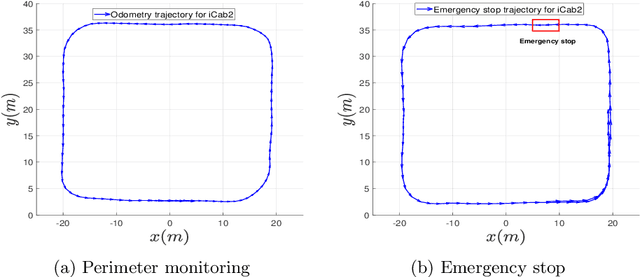Lucio Marcenaro
Interactive Bayesian Generative Models for Abnormality Detection in Vehicular Networks
Mar 06, 2024Abstract:The following paper proposes a novel Vehicle-to-Everything (V2X) network abnormality detection scheme based on Bayesian generative models for enhanced network self-awareness functionality at the Base station (BS). In the learning phase, multi-modal data signals contrived by the vehicles' integrated and sensing module are imbued into data-driven Generalized Dynamic Bayesian network (GDBN) models. Following that, during the testing phase, an Interactive Modified Markov Jump Particle filter (IM-MJPF) is utilized to forecast forthcoming network states and vehicle trajectories by leveraging the assimilated semantics embedded in the coupled multi-GDBNs. This approach involves learning statistically correlated association between evolving trajectories and network communication links. Security and surveillance of Internet of Vehicles (IOVs) links are performed online with high detection probabilities by matching predicted with observed network connectivity maps (graphs).
Intelligent Resource Allocation for UAV-Based Cognitive NOMA Networks: An Active Inference Approach
Oct 17, 2023Abstract:Future wireless networks will need to improve adaptive resource allocation and decision-making to handle the increasing number of intelligent devices. Unmanned aerial vehicles (UAVs) are being explored for their potential in real-time decision-making. Moreover, cognitive non-orthogonal multiple access (Cognitive-NOMA) is envisioned as a remedy to address spectrum scarcity and enable massive connectivity. This paper investigates the design of joint subchannel and power allocation in an uplink UAV-based cognitive NOMA network. We aim to maximize the cumulative sum rate by jointly optimizing the subchannel and power allocation based on the UAV's mobility at each time step. This is often formulated as an optimization problem with random variables. However, conventional optimization algorithms normally introduce significant complexity, and machine learning methods often rely on large but partially representative datasets to build solution models, assuming stationary testing data. Consequently, inference strategies for non stationary events are often overlooked. In this study, we introduce a novel active inference-based learning approach, rooted in cognitive neuroscience, to solve this complex problem. The framework involves creating a training dataset using random or iterative methods to find suboptimal resource allocations. This dataset trains a mobile UAV offline, enabling it to learn a generative model of discrete subchannels and continuous power allocation. The UAV then uses this model for online inference. The method incrementally derives new generative models from training data by identifying dynamic equilibrium conditions between required actions and variables, represented within a unique dynamic Bayesian network. The proposed approach is validated through numerical simulations, showing efficient performance compared to suboptimal baseline schemes.
Active Inference for Sum Rate Maximization in UAV-Assisted Cognitive NOMA Networks
Sep 20, 2023Abstract:Given the surge in wireless data traffic driven by the emerging Internet of Things (IoT), unmanned aerial vehicles (UAVs), cognitive radio (CR), and non-orthogonal multiple access (NOMA) have been recognized as promising techniques to overcome massive connectivity issues. As a result, there is an increasing need to intelligently improve the channel capacity of future wireless networks. Motivated by active inference from cognitive neuroscience, this paper investigates joint subchannel and power allocation for an uplink UAV-assisted cognitive NOMA network. Maximizing the sum rate is often a highly challenging optimization problem due to dynamic network conditions and power constraints. To address this challenge, we propose an active inference-based algorithm. We transform the sum rate maximization problem into abnormality minimization by utilizing a generalized state-space model to characterize the time-changing network environment. The problem is then solved using an Active Generalized Dynamic Bayesian Network (Active-GDBN). The proposed framework consists of an offline perception stage, in which a UAV employs a hierarchical GDBN structure to learn an optimal generative model of discrete subchannels and continuous power allocation. In the online active inference stage, the UAV dynamically selects discrete subchannels and continuous power to maximize the sum rate of secondary users. By leveraging the errors in each episode, the UAV can adapt its resource allocation policies and belief updating to improve its performance over time. Simulation results demonstrate the effectiveness of our proposed algorithm in terms of cumulative sum rate compared to benchmark schemes.
Integrated Sensing and Communication for Joint GPS Spoofing and Jamming Detection in Vehicular V2X Networks
Feb 01, 2023Abstract:Vehicle-to-everything (V2X) communication is expected to be a prominent component of the sixth generation (6G) to accomplish intelligent transportation systems (ITS). Autonomous vehicles relying only on onboard sensors cannot bypass the limitations of safety and reliability. Thus, integrated sensing and communication is proposed as an effective way to achieve high situational- and self-awareness levels, enabling V2X to perceive the physical world and adjust its behaviour to emergencies. Secure navigation through the Global Positioning System (GPS) is essential in ITS for safe operation. Nevertheless, due to the lack of encryption and authentication mechanisms of civil GPS receivers, spoofers can easily replicate satellite signals by launching GPS spoofing attacks to deceive the vehicle and manipulate navigation data. In addition, due to its shared nature, V2X links are prone to jamming attacks which might endanger vehicular safety. This paper proposes a method to jointly detect GPS spoofing and jamming attacks in a V2X network. Simulation results demonstrate that the proposed method can detect spoofers and jammers with high detection probabilities.
A Novel Resource Allocation for Anti-jamming in Cognitive-UAVs: an Active Inference Approach
Aug 10, 2022

Abstract:This work proposes a novel resource allocation strategy for anti-jamming in Cognitive Radio using Active Inference ($\textit{AIn}$), and a cognitive-UAV is employed as a case study. An Active Generalized Dynamic Bayesian Network (Active-GDBN) is proposed to represent the external environment that jointly encodes the physical signal dynamics and the dynamic interaction between UAV and jammer in the spectrum. We cast the action and planning as a Bayesian inference problem that can be solved by avoiding surprising states (minimizing abnormality) during online learning. Simulation results verify the effectiveness of the proposed $\textit{AIn}$ approach in minimizing abnormalities (maximizing rewards) and has a high convergence speed by comparing it with the conventional Frequency Hopping and Q-learning.
Container Localisation and Mass Estimation with an RGB-D Camera
Mar 02, 2022



Abstract:In the research area of human-robot interactions, the automatic estimation of the mass of a container manipulated by a person leveraging only visual information is a challenging task. The main challenges consist of occlusions, different filling materials and lighting conditions. The mass of an object constitutes key information for the robot to correctly regulate the force required to grasp the container. We propose a single RGB-D camera-based method to locate a manipulated container and estimate its empty mass i.e., independently of the presence of the content. The method first automatically selects a number of candidate containers based on the distance with the fixed frontal view, then averages the mass predictions of a lightweight model to provide the final estimation. Results on the CORSMAL Containers Manipulation dataset show that the proposed method estimates empty container mass obtaining a score of 71.08% under different lighting or filling conditions.
Self-awareness in intelligent vehicles: Feature based dynamic Bayesian models for abnormality detection
Oct 29, 2020



Abstract:The evolution of Intelligent Transportation Systems in recent times necessitates the development of self-awareness in agents. Before the intensive use of Machine Learning, the detection of abnormalities was manually programmed by checking every variable and creating huge nested conditions that are very difficult to track. This paper aims to introduce a novel method to develop self-awareness in autonomous vehicles that mainly focuses on detecting abnormal situations around the considered agents. Multi-sensory time-series data from the vehicles are used to develop the data-driven Dynamic Bayesian Network (DBN) models used for future state prediction and the detection of dynamic abnormalities. Moreover, an initial level collective awareness model that can perform joint anomaly detection in co-operative tasks is proposed. The GNG algorithm learns the DBN models' discrete node variables; probabilistic transition links connect the node variables. A Markov Jump Particle Filter (MJPF) is applied to predict future states and detect when the vehicle is potentially misbehaving using learned DBNs as filter parameters. In this paper, datasets from real experiments of autonomous vehicles performing various tasks used to learn and test a set of switching DBN models.
Self-awareness in Intelligent Vehicles: Experience Based Abnormality Detection
Oct 28, 2020



Abstract:The evolution of Intelligent Transportation System in recent times necessitates the development of self-driving agents: the self-awareness consciousness. This paper aims to introduce a novel method to detect abnormalities based on internal cross-correlation parameters of the vehicle. Before the implementation of Machine Learning, the detection of abnormalities were manually programmed by checking every variable and creating huge nested conditions that are very difficult to track. Nowadays, it is possible to train a Dynamic Bayesian Network (DBN) model to automatically evaluate and detect when the vehicle is potentially misbehaving. In this paper, different scenarios have been set in order to train and test a switching DBN for Perimeter Monitoring Task using a semantic segmentation for the DBN model and Hellinger Distance metric for abnormality measurements.
Collective Awareness for Abnormality Detection in Connected Autonomous Vehicles
Oct 28, 2020



Abstract:The advancements in connected and autonomous vehicles in these times demand the availability of tools providing the agents with the capability to be aware and predict their own states and context dynamics. This article presents a novel approach to develop an initial level of collective awareness in a network of intelligent agents. A specific collective self awareness functionality is considered, namely, agent centered detection of abnormal situations present in the environment around any agent in the network. Moreover, the agent should be capable of analyzing how such abnormalities can influence the future actions of each agent. Data driven dynamic Bayesian network (DBN) models learned from time series of sensory data recorded during the realization of tasks (agent network experiences) are here used for abnormality detection and prediction. A set of DBNs, each related to an agent, is used to allow the agents in the network to each synchronously aware possible abnormalities occurring when available models are used on a new instance of the task for which DBNs have been learned. A growing neural gas (GNG) algorithm is used to learn the node variables and conditional probabilities linking nodes in the DBN models; a Markov jump particle filter (MJPF) is employed for state estimation and abnormality detection in each agent using learned DBNs as filter parameters. Performance metrics are discussed to asses the algorithms reliability and accuracy. The impact is also evaluated by the communication channel used by the network to share the data sensed in a distributed way by each agent of the network. The IEEE 802.11p protocol standard has been considered for communication among agents. Real data sets are also used acquired by autonomous vehicles performing different tasks in a controlled environment.
Dynamic Bayesian Approach for decision-making in Ego-Things
Oct 28, 2020



Abstract:This paper presents a novel approach to detect abnormalities in dynamic systems based on multisensory data and feature selection. The proposed method produces multiple inference models by considering several features of the observed data. This work facilitates the obtainment of the most precise features for predicting future instances and detecting abnormalities. Growing neural gas (GNG) is employed for clustering multisensory data into a set of nodes that provide a semantic interpretation of data and define local linear models for prediction purposes. Our method uses a Markov Jump particle filter (MJPF) for state estimation and abnormality detection. The proposed method can be used for selecting the optimal set features to be shared in networking operations such that state prediction, decision-making, and abnormality detection processes are favored. This work is evaluated by using a real dataset consisting of a moving vehicle performing some tasks in a controlled environment.
 Add to Chrome
Add to Chrome Add to Firefox
Add to Firefox Add to Edge
Add to Edge